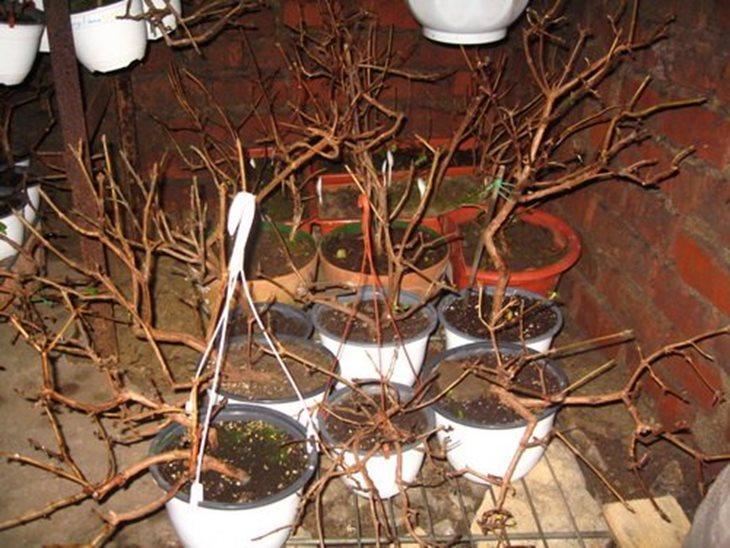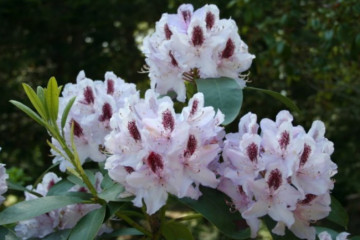Fuchsia cultivation and care in the garden, in the open field
Content:
Bright fuchsia covered with flowers is the best decoration for any garden or country house. It is used for decorative purposes. In order for a plant to please with its beauty, it is important to follow some rules of care and cultivation. Following the tips below will keep your flower looking healthy and lush.
Description of fuchsia garden perennial
Fuchsia owes its name to a German doctor L. von Fuchs, who is considered the "father of botany".
Fuchsia branches are distinguished by their flexibility, the aspiration of the crown downward.
The leaves are bright green, oval in shape. Their length is about 5 cm. The ends are pointed, and the edges of the leaves have a serrated border. The stems are light reddish in color. Sometimes foliage also takes on this shade.
The flowers of the plant are single, directed downward. They are shaped like a bowl. Flowers are double, simple and semi-double. Their color varies: orange, lilac, cream, white, pink, blue and purple.
Flowering continues for a long period of time. Flowers at this time more and more rush down and wither by the end of flowering.
Fuchsia is an annual or perennial plant
Fuchsia belongs to the genus of exotic perennial plants. But since this is a thermophilic flower, in northern latitudes it is one of the annuals.
Fuchsia: growing and caring for the garden in the country
Fuchsia on the street requires sufficient attention to the rules of cultivation and care. She needs regular abundant watering. However, it is important to observe the measure, otherwise the roots of the plant will begin to rot. Watering is done 1-2 times a week in the morning. Between waterings, you should periodically spray the leaves of the plant, since it needs constant moisture. It is important to cut withered buds in time.
Can fuchsia be planted in open ground
For lovers of these flowers, the question often arises about whether it is possible to plant fuchsia in the garden in open ground. The answer to this question is yes. Planting is carried out in late spring - early summer (May-June), when the air temperature outside becomes high enough (about 20 ° C). The rules for planting and caring for fuchsia in the open field are simple. It is important to pay attention that the root collar is lowered no more than 20 cm into the ground.
The plant grows rapidly and begins to bloom. The flowering period takes approximately 2.5 weeks. Before you bury a flower for the cold season, it is better to give it the opportunity to survive the first frost. Thus, the plant is hardened.
How to plant fuchsia
To plant fuchsia in the garden in the country, you need fertile soil, slightly acidic or neutral (pH 6-7).
Fuchsias are thermophilic plants. However, there are several hybrid varieties that are patient and tolerant of cold climates.
It is best to provide the plant with wind-free areas in the garden with adequate lighting. Slight shadow is acceptable.
Reproduction of the plant takes place using seeds or vegetatively.
Planting a plant for vegetative propagation is carried out as follows. Woody shoots are selected.They are immersed in water or liquid substrate. After 2 weeks, roots appear. Cuttings should be done about once every three years. This will refresh the plant.
If the first breeding method was chosen, then planting is carried out in the first two months of spring. For this, containers are used. The seeds are covered with earth, but not much (3-4 cm). It is preferable to use peat tablets: they allow transplanting without damaging the root system of the flower. Then watering is carried out, and the container is closed with polyethylene.
The seedlings are planted in the soil, where there must be a drainage layer. After about 3 weeks, the plant is already adapting to new weather conditions and soil.
Fuchsia bush
How to plant bush fuchsia correctly? She is planted in pots one plant at a time. Do not use very large containers as the roots will start to rot. The small size of the pot is dangerous because the roots will begin to curl up, which will interfere with the normal development of the plant.
Fuchsia standard
For planting fuchsia standard, you need a bamboo peg and scissors. The landing procedure is as follows:
- When the central shoot of the plant is strong enough, you can begin to form a standard tree. The bottom line is that the central stem begins to grow straight up. In this case, not only its central orientation is important, but also the absence of barrel bends. To do this, it is necessary to tie the central apical shoot to the peg and remove all other shoots that have appeared on the side.
- The peg is driven into the ground as close to the center stem as possible. Together they are tied with any soft material. You can use a satin ribbon. Do not cut off all lateral shoots from the central stem at once. You need to leave some of them so that the trunk grows in thickness. Also, large leaves should not be cut. They give the trunk strength as it grows. It is necessary to prevent the flowering of fuchsia to allow it to grow stronger.
- The following dimensions of the trunk are considered optimal: 105 cm in height and 75 cm in diameter of the crown. There are also sizes that are half the standard size (75 cm high, crown diameter 45 cm) or quarter (height 45 cm and crown diameter 25 cm).
- When the plant reaches the chosen height, you need to pinch the top of the shoot.
- After that, a balanced fertilization is applied.
- Then the formation of the trunk begins. Any shape can be chosen (umbrella, spherical, triangular, etc.). A good stem will turn out if you cut it horizontally, make a split in the middle and graft it.
- After that, the cuttings are prepared. An oblique cut is made on them, on the reverse side - a horizontal one.
- The stalk is inserted into the split of the stem. A transparent polyethylene tape is tightly applied to the place of their connection.
- The crown is formed until the end of the season.
Fuchsia ampelous: growing in the garden
Fuchsia ampelous is also an outdoor plant that performs a decorative function. It is best to plant it in pots or hanging baskets in the garden. The use of ceramics is not recommended.
Wire baskets work best. Fill them with peat moss and add perlite and vermiculite. This will retain moisture, which will reduce the amount of water needed for plant growth. The mixture must be soaked in water before placing in the basket.
Fuchsia is short-lived: over time, it begins to grow upwards and undergoes lignification. Therefore, old plants periodically need to be replaced with young bushes that are grown from cuttings.
In winter, gardeners usually tend to fuchsia at home by transferring it from the garden. The flower is placed in a room provided with light and warmth. However, if such a possibility is absent, then a stalk is cut off from the main plant, from which roots begin to grow in the future. They should be kept in clay pots pre-filled with vermiculite. After 3 weeks, the development of a new root system will begin, and the fuchsia can be transplanted into the soil. Keep the plant on a well-lit windowsill. Before planting in the garden, it is important not to forget to harden the flowers.
How to feed fuchsia in spring
You can feed fuchsia in the spring with any fertilizers developed specifically for this plant. You can also use those that are prepared for all flowering species. Complex fertilizers are also suitable.
Feeding should be done once a week.
Fertilizer for fuchsia
Fuchsia garden perennial responds favorably to regular fertilization. However, you should be careful with feeding in the early stages. It is better for the flower to absorb nutrients from the soil.
Among organic fertilizers, it is suitable for:
- Fertimix. The basis of the preparation is vermicompost, which contributes to giving the leaves and flowers a healthy and bright color. The formation of dense buds is also ensured. Fertilizer can be used once every 2 weeks. For 1 liter of pure water, 20 ml of Fertimix is used.
- Peat oxidate. It is used every day for foliar feeding and leaf nutrition. It also has a beneficial effect on the formation of shoots.
- Bone flour. It is not necessary to loosen the soil after fertilization. Used 1 tbsp. spoon for one flower pot.
- You can also apply mullein or horse manure once every 2-3 weeks, wood ash and humus.
How to feed fuchsia for abundant flowering
Abundant flowering of fuchsia will be ensured by using phosphorus and potassium for feeding (preparations of Kemir, Plantafol, Crystallon). They contribute to the formation of a large number of buds with a bright, rich color and regular shape.
Top dressing is best applied 2-5 times a week, but in small portions.
Fuchsia on the balcony: growing and care
Fuchsia does not survive the heat and lack of moisture in the air. The flowers become small from this, and sometimes the buds do not open at all.
The plant does not tolerate the scorching sun, although the morning rays are good for the flower. Starting from noon until the evening, it is recommended to place the fuchsia in partial shade. The balconies on the east and north sides are best suited for the plant.
Fuchsia on the balcony is placed in a pots so that it does not overheat under the scorching rays of the sun. For this it is worth using blinds or curtains. You can try to place the flower so that the sun hits the foliage and buds and does not affect the roots. To do this, it is hung from the wall.
If there is a lack of light and heat, it is necessary to provide the plant with phytolamps or simple fluorescent lamps.
Fuchsia is bad for constant movement during flowering. The plant can simply shed all the buds.
When you can take fuchsia outside
Fuchsia loves warmth, but does not tolerate heat.You can take it outside with the onset of summer heat. The temperature should be approximately 20 ° C. Moderate temperatures, humidity and ambient light are the key to proper cultivation and outdoor care for fuchsia.
Fuchsia in the garden is either transplanted into the ground, or remains standing in the pot. A place is chosen that is sufficiently lit, with protection from direct sun and strong winds.
Outdoor temperature
An increase in air temperature indicators of more than 25 ° C for the normal growth of fuchsia and the formation of buds should not be. High temperatures are dangerous because the leaves and flowers will begin to wither, and the plant will discard them altogether. The risk of developing diseases also increases.
The minimum temperature threshold is 5-8 ° C. In the cold season, flower development is suspended until warmth.
Fuchsia is a garden flowering plant, unpretentious, but it will have to pay some attention, saving it from the scorching rays of the sun and lack of moisture in summer. It is important not to forget that fuchsia is one of the exotic plants intended for cultivation in an area with a warm climate. In winter, flowers growing in the garden must be covered so that they do not die. Be sure to temper the fuchsia before returning to the fresh air. Flowers respond well to feeding, delighting gardeners with their bright and rich colors and lush shapes.




















